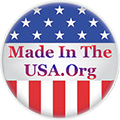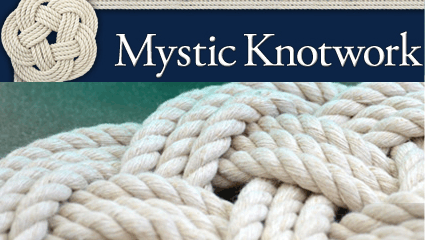One of the products Mystic Knotwork sells is American Made Bracelets. A more complete list of their products is provided by Made in America Secrets, to review their list click here.
For more information about Mystic Knotwork and its Made in America products see the following:
We thank you for supporting our mission to keep the maritime tradition of knotwork alive. Even the humble sailor bracelet can be a means to touch the past that stretches back centuries.
For our family it all started in 1939 when my grandfather worked on the McCormick line acting as a bosun's mate on cargo ships running between Argentina and New York City. In New York City, he Alton Beaudoin Showing a Knotted Frame in progresswould stay at the Seaman's Institute. After showing interest in knots, the retired captains and officers that were staying there showed him a few knots to work on while out to sea. Invariably upon his return, they would show him all the mistakes in his workmanship and through this schooling he learned the art. His skills were honed by weeks at sea and the stern eye of his skilled teachers. As the years went on, he developed talents nearly equal to theirs. Toward the end of Alton's time in the merchant marine, he was teaching Able Bodied Seamanship in the New York Harbor.
When World War II broke out, Alton went from a Bosun's mate in the merchant marines to a private in the US Army, soley because he wore glasses. He never talked much about his time in the Pacific Theater, but we all knew he had a rough time, not only because of the 3 purple hearts he earned.
After serving in World War II, he returned home with sad memories of war and loss of many friends. He didn't talk much about it, but he used is talent with cord as his escape from these memories.
By 1957, Alton had established himself as an expert in knotwork with pieces donated to the Smithsonian, he turned his artistic passion to a business selling the traditional sailor knot bracelet as well as fancier belts, sample boards, guitar straps, and bellropes. In fact, one of his bellropes was used for more than a decade aboard the USCG Barque Eagle.
Here is an article about him from October of 1976 in The New London Day
All of this history was passed to his sons and grandchildren. I remember clearly the weekend trips with my grandparents learning macram?, splicing, sennit work, and other fancy knotwork. My cousins and I used to race to see who could make twenty sailor knot bracelets the fastest. I didn't always win, but through the competition, we learned how to tie one knot excessively well. My childhood is definitely one that I treasure, Finished Nautical Frame Alton Beaudoin Mystic KnotworkI wish everyone could have experienced such a tight knit loving family.
Our whole family carries on the traditions started by my grandfather. My uncle ties macram? and sailor knots, but is better known for his castings of authentic knotwork. Because he casts in gold and silver, his artwork lasts more than a lifetime. My brother has applied what he learned directly to metal and has earned a reputation for his artistry. My sister translated her love for the sea and history into her career designing the Defender Co. online catalog. My father still works with me to help improve my splicing and keeps me humble with his attention to detail.
My wife and I continue the traditional skill of turning cord into art. Most well known are the white sailor bracelets, but with my wife and daughter we have added a modern flair adding color and patterns. In addition to sailor bracelets, we also make rope mats, table top centerpieces , wedding favors, and macram? work. My wife's macram? is so popular people have actually bought it right off her neck!
Thank you for taking the time to learn a little bit about our family history and hope you enjoy your purchase. All of our work is American made here in Connecticut from supplies also found in the USA.
Sincerely,
Matthew Beaudoin
February 8, 2010
For more information about Mystic Knotwork and its Made in America products see the following:
We thank you for supporting our mission to keep the maritime tradition of knotwork alive. Even the humble sailor bracelet can be a means to touch the past that stretches back centuries.
For our family it all started in 1939 when my grandfather worked on the McCormick line acting as a bosun's mate on cargo ships running between Argentina and New York City. In New York City, he Alton Beaudoin Showing a Knotted Frame in progresswould stay at the Seaman's Institute. After showing interest in knots, the retired captains and officers that were staying there showed him a few knots to work on while out to sea. Invariably upon his return, they would show him all the mistakes in his workmanship and through this schooling he learned the art. His skills were honed by weeks at sea and the stern eye of his skilled teachers. As the years went on, he developed talents nearly equal to theirs. Toward the end of Alton's time in the merchant marine, he was teaching Able Bodied Seamanship in the New York Harbor.
When World War II broke out, Alton went from a Bosun's mate in the merchant marines to a private in the US Army, soley because he wore glasses. He never talked much about his time in the Pacific Theater, but we all knew he had a rough time, not only because of the 3 purple hearts he earned.
After serving in World War II, he returned home with sad memories of war and loss of many friends. He didn't talk much about it, but he used is talent with cord as his escape from these memories.
By 1957, Alton had established himself as an expert in knotwork with pieces donated to the Smithsonian, he turned his artistic passion to a business selling the traditional sailor knot bracelet as well as fancier belts, sample boards, guitar straps, and bellropes. In fact, one of his bellropes was used for more than a decade aboard the USCG Barque Eagle.
Here is an article about him from October of 1976 in The New London Day
All of this history was passed to his sons and grandchildren. I remember clearly the weekend trips with my grandparents learning macram?, splicing, sennit work, and other fancy knotwork. My cousins and I used to race to see who could make twenty sailor knot bracelets the fastest. I didn't always win, but through the competition, we learned how to tie one knot excessively well. My childhood is definitely one that I treasure, Finished Nautical Frame Alton Beaudoin Mystic KnotworkI wish everyone could have experienced such a tight knit loving family.
Our whole family carries on the traditions started by my grandfather. My uncle ties macram? and sailor knots, but is better known for his castings of authentic knotwork. Because he casts in gold and silver, his artwork lasts more than a lifetime. My brother has applied what he learned directly to metal and has earned a reputation for his artistry. My sister translated her love for the sea and history into her career designing the Defender Co. online catalog. My father still works with me to help improve my splicing and keeps me humble with his attention to detail.
My wife and I continue the traditional skill of turning cord into art. Most well known are the white sailor bracelets, but with my wife and daughter we have added a modern flair adding color and patterns. In addition to sailor bracelets, we also make rope mats, table top centerpieces , wedding favors, and macram? work. My wife's macram? is so popular people have actually bought it right off her neck!
Thank you for taking the time to learn a little bit about our family history and hope you enjoy your purchase. All of our work is American made here in Connecticut from supplies also found in the USA.
Sincerely,
Matthew Beaudoin
February 8, 2010

